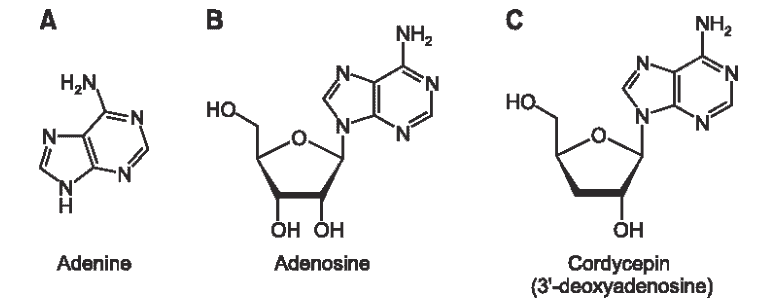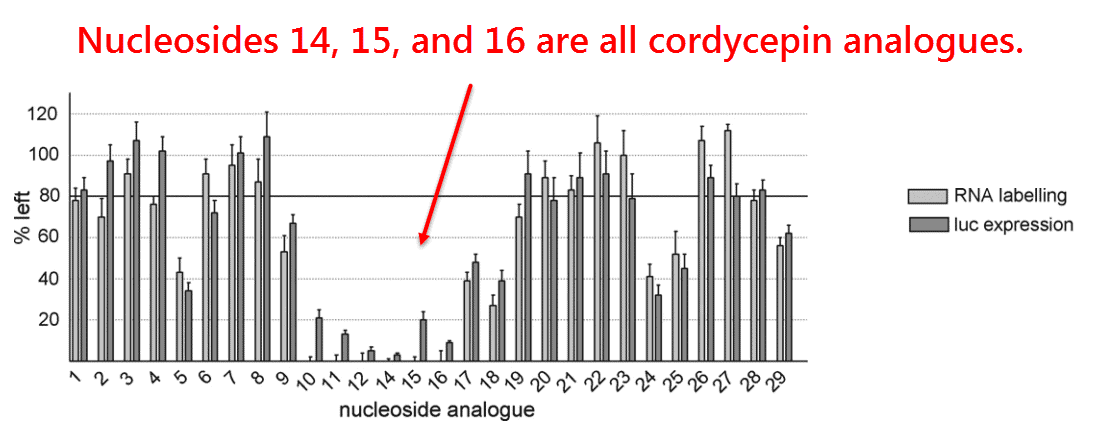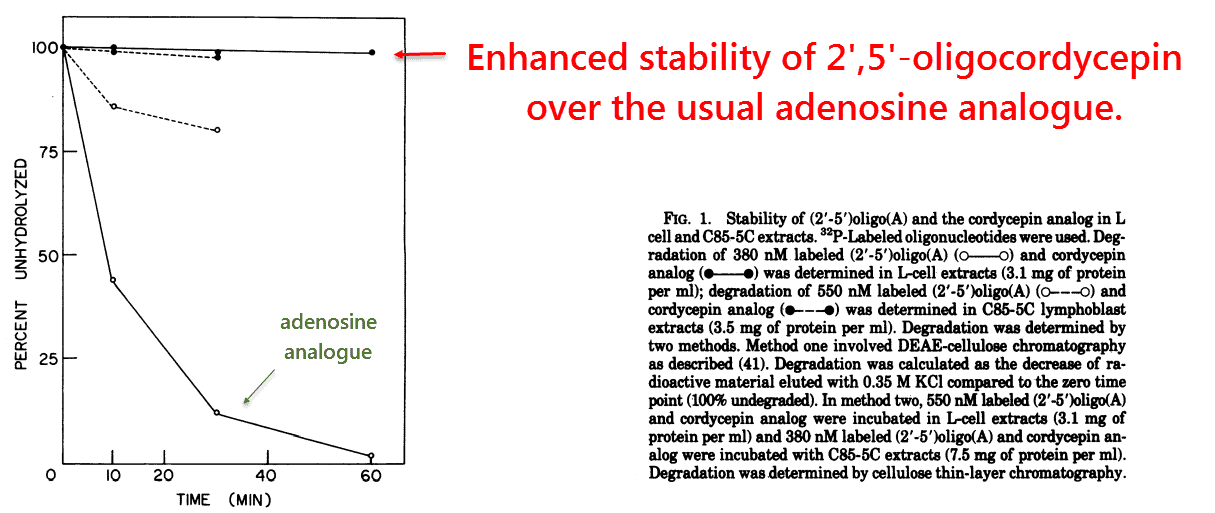
Here’s how to easily kill off bad bacteria and viruses that lead to illness…
—-Important Message—-
Secret molecule can make men live and perform “like teenagers again”

Imagine being able to rewind your internal clock…so instead of feeling like your age, you feel decades younger…
I’m talking about waking up full of energy, with a huge tent in the sheets from your massive morning wood…
Eating a slice of pizza, drinking a beer… and never feeling guilty about it or worrying about it turning into belly fat.
And when you take a woman to bed, you are ready for her…
You are rigid and ready, and you have the stamina to go for an hour or more…
Now any man can live this way again, no matter his age.
———-
Cordycepin — the best herbal treatment for viruses?
Cordycepin was discovered around 1950 in the pursuit of knowing why mycelia of Cordyceps militaris, a common fungi, were resistant to decay (Cunningham, 1950).
It was found that the antibacterial activity of C. militaris could be attributed to just one molecule, cordycepin, which was later found to be synonymous with 3′-deoxyadenosine (Kaczka, 1963).

Cordycepin had originally been studied on account of its antibacterial properties…
Yet investigations into its mechanism of action marked the first step towards its reutilization as an antiviral agent.
This is because it had been found to inhibit RNA synthesis by acting as a chain terminator and had, in fact, been the first treatment of this type ever discovered.
This fact makes cordycepin THE antiviral treatment — the model for all synthetic RNA/DNA chain terminators to follow.
Since that time, cordycepin has been shown to inhibit the following viruses in vitro:
- Adenovirus (Philipson, 1971)
- Sendai Virus (Mahy, 1973)
- Vesicular Stomatitis Virus (Soria, 1973)
- Rauscher Leukemia Virus (Richardson, 1975)
- Polio Virus (Dorsch-Häsler, 1975)
- Western Equine Encephalitis Virus (Hashimoto, 1976)
- Rhinovirus (Nair, 1976)
- Picornavirus (Panicali, 1977)
- Vaccinia Virus (Person, 1977)
- Rotavirus (Pizarro, 1991)
- Epstein-Barr Virus (Ryu, 2014)
- Hepatitis C Virus (Ueda, 2014)
So cordycepin isn’t just an “herbal treatment” that requires wishful thinking to work, but is the prototypical antiviral treatment.
A slightly modified cordycepin molecule, 3′-amino-3′-deoxyadenosine, had been found to be the most potent nucleoside analogue out of 29 tested (Pohjala, 2008).

The most effective antivirals tested happened to be adenosine analogues and the reason is clear:
Adenosine occupies a special place in viral replication because it forms not only ~25% of the main RNA sequences, but 100% of the polyadenylate tails needed for transcription.
This is why adenosine analogues are more potent than uridine, guanosine, and cytidine analogues at inhibiting viral RNA replication.
Cordycepin is a special type of adenosine analogue.
It is identical to adenosine in every respect besides lacking 3′-hydroxyl groups, the reason why it cannot form standard RNA bonds.
It is also quite safe when taken orally and appears to be non-mutagenic in normal cells.
“When the ‘treatment’ was administered daily over a seven day period at a dosage up to 300 mg⁄kg of body weight it was found to be uniformly tolerated.” ―Guarino, 1967
Cordycepin also has an additional mode of action that makes it even more potent, extremely effective, and completely unique among antivirals:

This study had examined the effects of cordycepin on rotaviral infections of rats and human cell lines.
They had confirmed Pizarro’s 1991 study that cordycepin was indeed inhibitory towards rotavirus, both in mice and HT29 cells.

Now this can be explained by cordycepin’s known role as a chain-terminating nucleoside analogue, but not what was found later.
They had also discovered that cordycepin could induce the expression of type-I interferons, powerful cytokines originally named on account of their ability to “interfere” with growth of the influenza virus.
Since that time, interferons-α and -β have been shown to induce an entire array of virus-specific enzymes and signalling proteins within cells.
If anything deserves to be called “antiviral cytokines,” type-I interferons would be it.

Interferons-α and -β are induced through the receptors RIG-I and MDA5 by binding viral RNA.
This fact supports the specific antiviral role of type-I interferons, while also giving clues towards cordycepin’s mode of action.
The researchers were able to show that RIG-I was involved in this process, at least partially, by “knocking it down” using small interfering RNA (siRNA).

This technique prevents the expression of RIG-I by selectively hybridizing the mRNA that encodes it with its complementary strand…
Thereby forming an inactive double-stranded helix.
In this same manner they’d shown that every signalling component downstream of RIG-I was -3, yet were unsure of how exactly cordycepin was accomplishing this.
They had tried computer modeling to dock cordycepin in the RIG-I activation domain but this remained unconvincing.
Obviously, a small nucleoside analogue is on an entirely different scale than an entire RNA chain.
For this reason, it’d seem quite unlikely that cordycepin could activate RIG-I directly; there must be some other way…
Fortunately for us, the answer has already been published in a few articles overlooked by these researchers.
While it’s true that cordycepin cannot participate in forming your standard 3′,5′-linked RNA chains because it lacks the 3′-hydroxyl group, it has been shown to form 2′,5′-linked chains.
“If the possibility exists that cordycepin can be incorporated into the DNA molecule, as these indirect results seem to indicate, it implies that such a polymer […] must have some 2’‑5’‑phosphodiester bonds rather than the conventional 3’‑5’‑phosphodiester bonds known to occur in RNA and DNA.” ―Guarino, 1967
This would forever remain a trivial curiosity if it weren’t for an important fact:
There exists an antiviral signalling molecule called 2′-5′-oligoadenylate, and cordycepin can become it.
Or that is to say, cordycepin can become something extremely similar:

This small oligomer is formed by the enzyme 2′-5′-oligoadenylate synthetase in response to viral RNA.
It’s only known function is act as an activator of ribonuclease L, an enzyme that degrades RNA within the cell.
This degradation of cytosolic RNA forms the basis of its antiviral properties.
The cordycepin analogue has also been shown to activate ribonuclease L (Kariko, 1987), yet is significantly more stable than the usual adenosine analogue (Doetsch, 1981).
This is because the cordycepin analogue is completely resistant to the enzyme 2’-phosphodiesterase, unlike its cousin 2′-5′-oligoadenylate.
“The lifetimes of the (2’‑5’)‑adenosine oligomers are severely restricted by the presence of an exonucleolytic 2’‑phosphodiesterase which rapidly degrades the (2’‑5’)‑phosphodiester linkages of the activators.” ―Wasner, 1994
The fact that 2′-5′-oligocordycepin is actually synthesized in cells has been proven, and it’s antiviral activity is ON PAR with the adenosine analogue:

Its antiviral efficacy had first been reported in this study, although it had been synthesized many times previously.
Using purified 2′-5′-oligoadenylate synthetase and cordycepin, they had created and purified 2′-5′-oligomers…
…and converted them into their “core” structures by removing two terminal phosphate groups.
This minor change was done to make them more cell-permeable, yet of course they’re naturally formed within cells as the full-length form.
Other slight modifications have been accomplished by others for increasing cell penetration such as by attaching vitamins A, D, and E to them.
So these researchers had confirmed earlier findings that 2′,5′-oligocordycepin is much more stable than the adenosine analogue:

This of course means that it’d be expected to act longer, perhaps even accumulating within cells in response to viral infection.
“The 32P-labeled core cordycepin analog is stable in C85-5C lymphoblast media (no degradation after 6 hr), is taken up, but is not metabolized.” ―Doetsch, 1981
They had also shown that it inhibits the ability of Epstein-Barr virus to infect cells just as well as standard 2′,5′-oligoadenylate.
This could mean that 2′,5′-oligocordycepin is an improvement over the regular adenosine type, a molecule with a half-life of only 2 minutes.
The researchers seem to agree.
They propose using 2′,5′-oligocordycepin as an antiviral treatment to replace interferon:
“Core trimer, core tetramer, and core cordycepin analog may be used to either supplement or replace interferon in those cells that are permeable to the core nucleotides. The core cordycepin analog is of particular interest owing to its antiviral effect coupled with its extended metabolic stability without toxicity to cells.” ―Doetsch, 1981
So we now know that 2′,5′-oligocordycepin activates ribonuclease L and has an antiviral effect…
But is this how cordycepin induces interferon? Does it bind RIG-I directly?
Well…no, but here’s how it does it:

This was a follow-up of their previous study showing that 2′,5′-oligoadenlyate could induce the expression of dozens of enzymes, including many interferon-stimulated genes (Malathi, 2005).
So in the pursuit of figuring out exactly how it could do this, they had focused first on ribonuclease L — the only known target of 2′,5′-oligoadenlyate.
They had discovered that cells lacking ribonuclease L expression could not induce interferon-β in response to 2′,5′-oligoadenlyate yet those having ribonuclease L could.
They’d also found that every known signalling component DOWNSTREAM of ribonuclease L was also required, just as with the cordycepin study above.

So 2′,5′-oligoadenylate appeared to be stimulating interferon-β production through well-established pathways, but there was still a missing link.
Where was the RNA coming from to signal RIG-I and MDA5?
2′,5′–oligoadenylate ⟶ ribonuclease L ⟶ ??? ⟶ RIG–I & MDA5 ⟶ IPS–1 ⟶ IRF–3 ⟶ interferon–β
To answer this question, they’d extracted all RNA from the cells and used purified ribonuclease L to cleave it into smaller products.
They had then added these smaller RNA fragments to other cells and had, surprisingly, found a massive increase in interferon-β synthesis.

They’d even shown that all downstream elements were absolutely essential to this process, confirming that the RIG-I pathway was involved.
So it’s finally known how 2′,5′–oligoadenylate induces interferon–β, through hydrolyzed self-RNA.
From this it can also be supposed that cordycepin also induces interferon-β through the very same mechanism which, on account of the enhanced stability of its 2′,5′-oligomer, could occur even during basal conditions.
This seems likely considering that Cordyceps militaris has been shown to increase survival in mice infected with influenza at doses of only 30 mg⁄kg (Lee, 2014), while also inducing an immunomodulatory effect.
This would correspond to only 51 μg⁄kg cordycepin (QunYing, 2009), a dose likely too small to be effective through its chain terminator activity..
—-Important Message For Men Worried About Getting A Virus—-
Believe it or not, even the CDC admits: Flu shots are only 14% effective at preventing flu viruses…
…that’s why I’m using my own Flu and Virus protocol that is working for me in two ways:
- Helping my body naturally resist viruses on its own…
- and by counteracting the cytokines that are responsible for terrible symptoms and even death if I do get sick
I like to think of my Flu & Virus Protocol like a limiter on my car engine.
The limiter won’t let me rev the engine so high that it breaks the engine…
Well, same thing with my Protocol.
I believe it will rev up my immunity — but that it won’t let my immunity get so get out of hand that it kills me with the dreaded cytokine storm.
And right now, I’m letting other men try it for free — click here
———-
